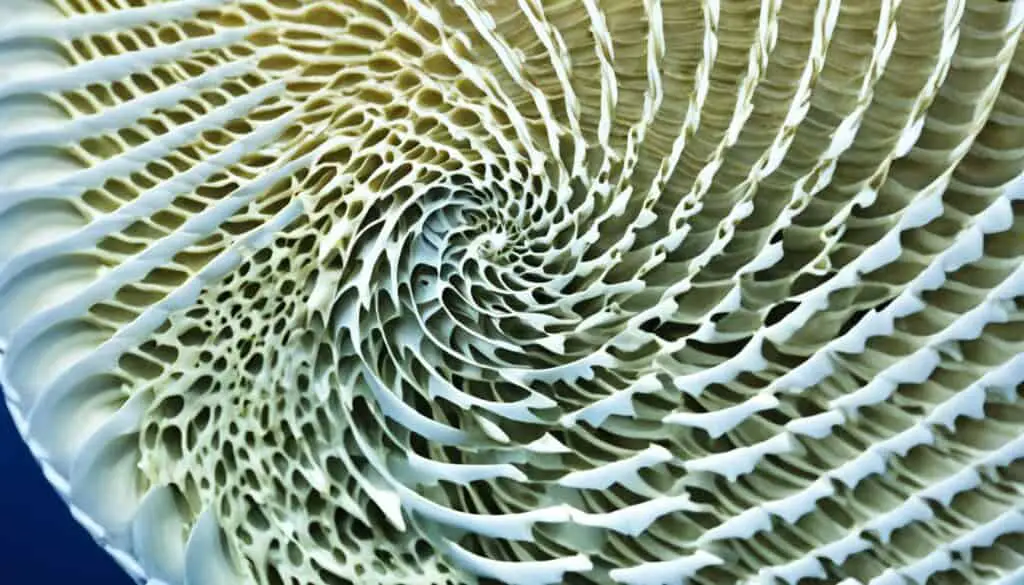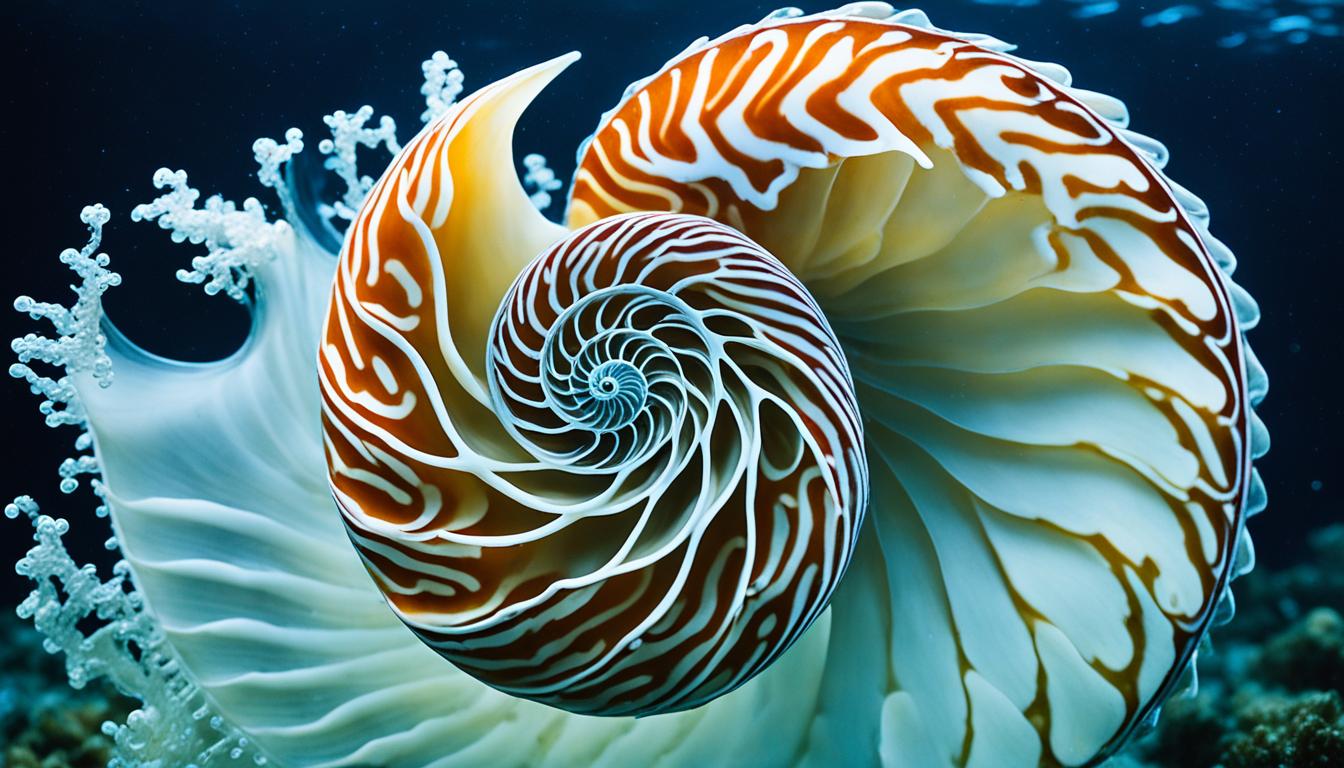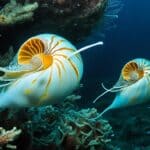The nautilus is an ancient sea creature that has been around for over 500 million years. It’s known as a “living fossil.” These creatures move in a unique way, thanks to their special body structure. They have been able to adapt to changes in the ocean over time.
Nautiluses move using a method called jet propulsion. This process is closely tied to their body’s design. Let’s dive into how they move through the water with such ease and efficiency.
Nautilus Anatomy and Locomotion
The nautilus has a unique anatomy that helps it move through water. It has a head with many tentacles, from 50 to over 90. These tentacles help catch food and move around. The shell is a key part of its anatomy, vital for survival.
Physical Structure of Nautilus
The nautilus’s shell has many chambers that can hold gas or liquid. This helps it control its buoyancy in the water. The design of the shell and its anatomy shows how each part helps with movement and staying stable.
The Function of the Shell in Movement
The movement of the nautilus depends on gas and liquid in its shell. The siphuncle, a tube, connects the chambers and controls the gas and liquid mix. By changing this mix, the nautilus can control its buoyancy. This lets it move through the water in a unique way.
How do nautiluses move?
Nautiluses are fascinating creatures with a unique way of moving. They use a method called nautilus jet propulsion. This technique helps them move fast and agilely in the water. It’s key to understanding their behavior and lifestyle.
Jet Propulsion Explained
Nautiluses move by sucking water into their bodies and then pushing it out quickly through a muscular siphon. This action creates a force that pushes the nautilus forward. It’s a smart way for them to move quickly, helping them avoid predators and get around their home.
This method of movement is not just for survival. It also shows how they’ve adapted over time. It’s a key part of their evolution.
The Role of the Siphuncle
The siphuncle is a flexible tube inside the nautilus shell. It’s vital for controlling buoyancy and helping the nautilus move. It manages the flow of gases and fluids between the shell’s chambers.
This helps the nautilus stay stable while swimming. By changing the gas and fluid levels in the siphuncle, the nautilus can control its buoyancy. This shows how well they’ve adapted to life in the water.
| Movement Type | Mechanism | Functionality |
|---|---|---|
| Nautilus Jet Propulsion | Water expulsion through the siphon | Rapid escape from predators |
| Siphuncle Regulation | Control of gas and fluid in shell chambers | Buoyancy and stability management |
Nautilus Swimming Techniques
Nautiluses have amazing swimming skills that help them live in the sea. They move up and down and control their buoyancy. This lets them explore and hunt efficiently.
Vertical Movement and Buoyancy Control
The way nautiluses swim depends a lot on controlling their buoyancy. They change the air and liquid in their shells to move up or down easily. This helps them avoid predators and catch food. It’s like how submarines move underwater.
Directional Swimming and Maneuverability
Nautiluses are very agile in the water. The siphon helps them steer and move quickly. They can change direction by adjusting their body and using the siphon. This lets them dodge obstacles and get to their food fast. Their ability to move around is key in the underwater world.
Nautilus Propulsion Mechanisms
Nautiluses move in unique ways, thanks to their special body parts. These mechanisms help them move through the water. They are key to how nautiluses survive in the ocean.
Utilizing the Hyponome for Motion
The hyponome is vital for how nautiluses move. It lets them move by pulling water into a chamber. When they squeeze the hyponome, they push water out, making them move forward.
This hyponome movement helps them move slowly or quickly. It helps them swim and avoid dangers.
Water Intake and Expulsion Process
The way nautiluses push water out is key to their movement. When they take in water, it makes their body low-pressure inside. This is like a jet engine, showing how well these sea creatures have evolved.
The hyponome’s rhythm of squeezing and relaxing helps them keep moving. It lets them change direction fast, showing how adaptable they are.
Nautilus Movement Patterns in the Wild
Nautiluses show amazing movement patterns in their natural homes. They are mostly active at night. This is when they go out to find food, using special ways to eat crustaceans and invertebrates.
Nocturnal Behavior and Feeding Practices
At night, nautiluses use their chemosensory tentacles to find food. These tentacles are key for detecting prey. They help them find food in the dark ocean floor by sensing chemical signs.
Their night movements are like a dance as they search for food. This shows how they move skillfully in their dark environment.
Reef Habitat Navigation
Nautiluses are not just wandering in the ocean; they are great at navigating reefs. They control their buoyancy to move up, down, and hover among corals. This skill helps them find food and avoid predators.
Their movement and reef skills are key to their survival and success in the wild.
Evolutionary Perspective on Nautilus Movement
The nautilus shows us how ancient traits shape modern movement. These creatures are among the last of their kind, keeping many old features. Their unique shell and movement methods are key to their survival.
Looking at cephalopod movement, we see how evolution has shaped their ways over millions of years. The nautilus moves mainly by jet propulsion, showing how it has adapted to its marine world. This special way of moving helps it survive in different ocean environments.
The way the deep-sea nautilus moves is a mix of old and new. It has found an efficient way to move through the deep sea without using a lot of energy. This shows how it has adapted to the deep sea’s challenges.

Conservation and Future of Nautilus Movement
The need to save nautiluses is growing fast. They face many threats to their movement and survival. Human actions and pollution harm their homes. Also, the high demand for their shells makes them more vulnerable.
This puts a big pressure on their numbers. We must act fast to save their homes and how they move.
Nautiluses have slow breeding rates, so they can’t bounce back quickly from population drops. Protecting their marine homes is key to keeping nautilus populations and the other sea life they support. We need to control trade and support sustainable actions to fight overfishing and habitat loss.
Working on conservation efforts is crucial to make sure nautiluses continue to thrive. By pushing for laws that protect their homes and limit harmful trade, you can help save these amazing sea creatures. This will ensure their unique journey through the ocean continues for future generations.
FAQ
How do nautiluses move in the water?
Nautiluses move by jet propulsion. They expel water from their body to push themselves forward. This method helps them move through the water well.
What role does the nautilus shell play in its movement?
The nautilus shell is important for protection and controlling buoyancy. By changing the gas and liquid in its chambers, the nautilus can adjust its buoyancy. This is key for moving around.
Can you explain how jet propulsion works in nautiluses?
Jet propulsion in nautiluses means drawing water into their bodies and then pushing it out quickly through a muscular siphon. This lets them move fast and make agile turns in the water.
How does the siphuncle contribute to nautilus locomotion?
The siphuncle connects the gas-filled chambers in the nautilus shell. It helps control the fluid between these chambers. This is crucial for the nautilus to move and adjust its buoyancy.
What swimming techniques do nautiluses use?
Nautiluses use different swimming techniques. They control their siphon for direction and adjust their buoyancy to move through the ocean at different depths.
How does the hyponome facilitate nautilus movement?
The hyponome helps nautiluses move by contracting and relaxing. This structure lets them move quickly by taking in and expelling water.
What are the movement patterns of nautiluses in the wild?
Nautiluses move in specific ways, mainly at night. They use buoyancy to move through coral reefs and other places.
How has nautilus locomotion evolved over time?
Nautilus movement has changed over millions of years. These changes have helped them live in different marine environments. Their unique ways of moving give us clues about cephalopod evolution.
What conservation efforts are in place for nautiluses?
Nautiluses need protection from threats like habitat loss and overfishing. Saving their homes and controlling trade is key to keeping these creatures safe for the future.







